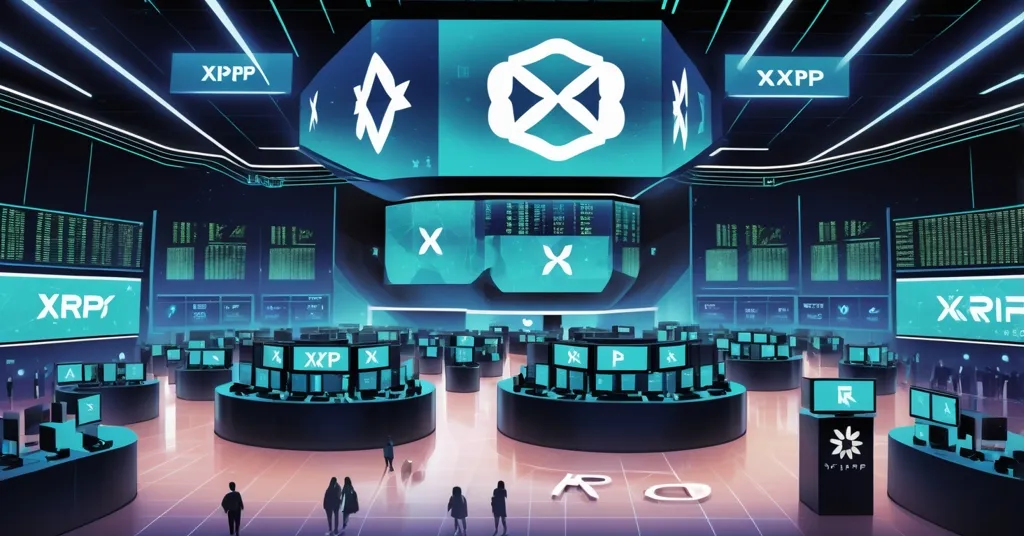Coinbase Launches Regulated XRP Futures, Paving Way for Mainstream Adoption

XRP Gets Major Boost as Regulated Futures Debut on Coinbase
Can Coinbase’s launch of regulated XRP futures catapult XRP into the mainstream financial market? The cryptocurrency world just got a jolt of excitement with Coinbase launching CFTC-regulated XRP futures, marking a pivotal moment for the digital asset as it inches closer to mainstream acceptance and market maturity.
- CFTC-regulated XRP futures on Coinbase
- Step towards potential XRP spot ETF
- XRP outpaces Solana in ETF race
- Current price dip amidst positive developments
The launch of CFTC-regulated XRP futures on Coinbase is more than just a new trading option; it’s a beacon of institutional acceptance in the crypto space. The Commodity Futures Trading Commission (CFTC) ensures that these futures are compliant with U.S. regulations, providing a safer trading environment. This move follows Coinbase Institutional’s strategic filing with the CFTC, a clear signal that the exchange is playing the long game with XRP. Earlier in the year, Bitnomial set the stage by introducing the first XRP futures, but Coinbase’s entry with regulated futures is a game-changer, reflecting a maturing market eager for more structured investment opportunities.
Regulated futures are often seen as the precursor to even bigger things, like a spot exchange-traded fund (ETF). A spot ETF directly tracks the asset’s price, offering investors a straightforward way to gain exposure to XRP. According to a recent Kaiko report, XRP is not just keeping pace but is actually outstripping Solana in the race for a U.S. spot ETF. The reason? Increased market depth, or more trading activity and liquidity. With over a dozen XRP ETF filings pending review by the incoming SEC Chair Paul Atkins, the future looks bright and busy for XRP.
Yet, it’s not all sunshine and rainbows for XRP. Despite these strides towards institutional acceptance, the cryptocurrency’s price is currently in the red, as CoinGecko data shows. It’s a reminder that while the regulatory landscape may be warming up to XRP, the market’s mood can be as unpredictable as ever. The bearish sentiment in the XRP options market on Deribit, where more people are betting on XRP’s price to go down, adds another layer of complexity to the picture. The recent approval of a 2x XRP ETF from Teucrium, which relies on European ETPs and swap agreements, further complicates the story. A 2x ETF aims to deliver twice the daily performance of XRP, and its introduction highlights the global nature of XRP’s journey towards mainstream acceptance.
The launch of regulated XRP futures on Coinbase is a testament to the growing maturity of the cryptocurrency market. It’s a clear step towards integrating digital assets into the traditional financial system, offering a safer way for institutions to gain exposure to XRP. But, as with any market, the road to widespread acceptance and price stability is fraught with ups and downs. Bitcoin maximalists might argue that this focus on XRP distracts from Bitcoin’s role as the true store of value, but even they must acknowledge that every step forward in the crypto space benefits the entire ecosystem. This development also aligns with the concept of “effective accelerationism,” potentially speeding up the integration of cryptocurrencies into traditional finance. As XRP navigates its path to mainstream acceptance, it’s crucial to consider its impact on decentralization and financial privacy, core values of the cryptocurrency revolution.
So, where does this leave XRP? On the cusp of something big, yet navigating the choppy waters of market sentiment and regulatory scrutiny. It’s a thrilling time to be a part of the cryptocurrency revolution, where every step forward is a potential leap towards mainstream acceptance. XRP’s journey to mainstream acceptance is like a rollercoaster – thrilling but not for the faint-hearted.
Key Takeaways and Questions
- What is the significance of regulated XRP futures on Coinbase?
Regulated XRP futures on Coinbase increase institutional acceptance and contribute to market maturity, providing a safer way for institutions to gain exposure to XRP.
- How do regulated futures impact the potential for a spot ETF?
Regulated futures are seen as a stepping stone towards the eventual launch of a spot ETF in the U.S., improving price discovery and reducing market manipulation.
- What does the Kaiko report indicate about XRP’s position relative to Solana?
The Kaiko report suggests that XRP has surpassed Solana in the race for a U.S. spot ETF due to its increased market depth, or more trading activity and liquidity.
- Who will be reviewing the pending XRP ETF filings?
The incoming SEC Chair, Paul Atkins, will be reviewing the over a dozen pending XRP ETF filings.
- How is XRP’s price performing according to the latest data?
XRP’s price is currently in the red, as indicated by CoinGecko data, despite the positive developments with the regulated futures.
- What is the difference between a spot ETF and a 2x XRP ETF?
A spot ETF directly tracks the asset’s price, while a 2x XRP ETF aims to deliver twice the daily performance of XRP.
- How might Bitcoin maximalists view this development?
Bitcoin maximalists might see the focus on XRP as a distraction from Bitcoin’s role as the true store of value, but even they must acknowledge that every step forward in the crypto space benefits the entire ecosystem.
- How does this development align with effective accelerationism?
This development aligns with effective accelerationism by potentially speeding up the integration of cryptocurrencies into traditional finance.
- What are the implications for decentralization and financial privacy?
As XRP navigates its path to mainstream acceptance, it’s crucial to consider its impact on decentralization and financial privacy, core values of the cryptocurrency revolution.



